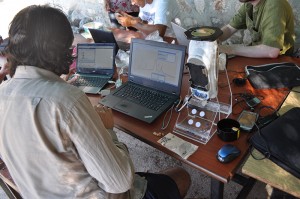(guest post by Megan Daniels, Kilian Mallon, and Matthieu Abgrall)
As a supplement to our visual analysis of the pottery, a second step is to run the sherds through the portable x-ray fluorescence analyzer, nicknamed the “ray-gun”, the tricorder, or just plain old XRF. We clip off a small section of the sherd, trying to make the surface of the sample as flat as possible. We place the sample directly on the tracer, and after clicking a billion buttons to calibrate it, the analyzer emits x-rays at the sherd for two minutes. Unfortunately it does not make any zapping sounds, so we have to remember to stay clear of the beam (generally it’s under the cover anyway) and to be wary when the big red light is flashing.
The XRF gives us an elemental breakdown of the sherd. Most pottery is made of the same stuff, so most of the readings look quite similar. We work off the assumption that each ancient pottery workshop got their clay locally. Thus, because rocks and clays differ slightly from place to place, and different human traditions also make pottery in slightly different ways and use pottery for different purposes, each workshop or region or time period should have a pottery fingerprint. We are looking for the tiny variation that can tell us the fingerprints for the pottery produced around Burgaz. Of course, a lot comes down to interpretation. The XRF is a tool that is only as useful as the archaeologist who uses it. We have spent a lot of time working out what data we need, and what it means.
We get levels of different elements in the pottery sherds we analyze. Through the Artax software and Excel, we are able to build a database with all the elemental breakdowns of the pottery. When possible, we also tie this data to a time period and a specific place of find or production, i.e a context or a workshop. When all the data is gathered, we can run several statistical analyses, such as simple correspondence analyses (CA) or more elaborate multicorrespondence analyses (MCA). The objective is to tell how close two pottery sherds are, when analyzed either according to the totality of their elemental profile, or solely on a part of their composition, such as iron, calcium and strontium. We run analyses of the levels of elements but also compare pottery sherds to find out what element is present or not. Our results take the form of bar charts and scatter graphs on which several fabrics will group together around one or two elements: what it will tell us is that those fabrics, because of their relative proximity, most likely are made out of the same clay source. When we add up the time and location data, we hope to link specific elemental compositions of pottery to specific workshops or time periods. Meanwhile we reserve additional visual and petrographic analyses to determine further the firing processes and the various “recipes” of potters. We pool all our resources together to get answers.
Through these efforts, we hope to tie Burgaz into its surrounding socio-economic environment and to understand better the changing uses of landscape and how this relates to Burgaz’s position at various periods in history, from a regional maritime center in the Classical and Hellenistic periods to (perhaps?) a more localized production site in the later Hellenistic and Roman periods.


